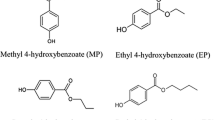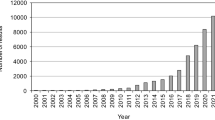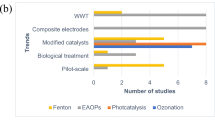Abstract
Chlorpyrifos (CPF), an organophosphate insecticide, due to its high efficiency and low cost is widely used in the agricultural industry. CPF may lead to lung deficiency, central nervous system damage, developmental and autoimmune disorders. In recent decades, the advanced oxidation processes (AOPs) have been considered in water and wastewater treatment due to their high efficiency in decomposition of organic and inorganic compounds, specially hardly biodegradable or non-biodegradable compounds. In the present review study, the most common AOPs (such as Fenton and Photo-Fenton processes, UV/H2O2 photolysis, UV/TiO2 heterogeneous photo catalysis, electrochemical processes, sonolysis technology, gamma irradiation technology and sulfate-based AOPs) applied for CPF removal from aqueous matrices has been investigated. It can be concluded that the use of AOPs are effective for CPF removal from aqueous media. In addition, Fenton and photocatalytic processes appear to be the most common techniques for CPF degradation.



Similar content being viewed by others
References
Khedr T, Hammad AA, Elmarsafy AM, Halawa E, Soliman M. Degradation of some organophosphorus pesticides in aqueous solution by gamma irradiation. J Hazard Mater. 2019;373:23–8. https://doi.org/10.1016/j.jhazmat.2019.03.011.
Ismail M, Khan HM, Sayed M, Cooper WJ. Advanced oxidation for the treatment of chlorpyrifos in aqueous solution. Chemosphere. 2013;93:645–51. https://doi.org/10.1016/j.chemosphere.2013.06.051.
Mahmood I, Imadi SR, Shazadi K, Gul A, Hakeem KR. Effects of pesticides on environment. Plant Soil Microbes. 2016:253–69.
Uniyal S, Sharma RK. Technological advancement in electrochemical biosensor based detection of organophosphate pesticide chlorpyrifos in the environment: a review of status and prospects. Biosens Bioelectron. 2018;116:37–50.
Katsikantami I, Colosio C, Alegakis A, Tzatzarakis MN, Vakonaki E, Rizos AK, et al. Estimation of daily intake and risk assessment of organophosphorus pesticides based on biomonitoring data–the internal exposure approach. Food Chem Toxicol. 2019;123:57–71. https://doi.org/10.1016/j.fct.2018.10.047.
Amalraj A, Pius A. Photocatalytic degradation of monocrotophos and chlorpyrifos in aqueous solution using TiO2 under UV radiation. J Water Process Eng. 2015;7:94–101.
Bakırcı GT, Acay DBY, Bakırcı F, Ötleş S. Pesticide residues in fruits and vegetables from the Aegean region. Turkey Food Chem. 2014;160:379–92. https://doi.org/10.1016/j.foodchem.2014.02.051.
Thind PS, Kumari D, John S. TiO2/H2O2 mediated UV photocatalysis of Chlorpyrifos: optimization of process parameters using response surface methodology. J. Environ. Chem. Eng. 2018;6:3602–9. https://doi.org/10.1016/j.jece.2017.05.031.
Ren Q, Yin C, Chen Z, Cheng M, Ren Y, Xie X, et al. Efficient sonoelectrochemical decomposition of chlorpyrifos in aqueous solution. Microchem J. 2019;145:146–53. https://doi.org/10.1016/j.microc.2018.10.032.
Liu H, Chen J, Wu N, Xu X, Qi Y, Jiang L, et al. Oxidative degradation of chlorpyrifos using ferrate (VI): kinetics and reaction mechanism. Ecotoxicol Environ Saf. 2019;170:259–66.
Gvozdenac S, Inđić D, Vuković S. Phytotoxicity of chlorpyrifos to white mustard (Sinapis alba L.) and maize (Zea mays L.): Potential indicators of insecticide presence in water. Pestic fitomed. 2013. https://doi.org/10.2298/PIF1304265G.
Deb N, Das S. Chlorpyrifos toxicity in fish: a review. Curr World Environ. 2013. https://doi.org/10.12944/CWE.8.1.17.
Moradeeya PG, Kumar MA, Thorat RB, Rathod M, Khambhaty Y, Basha S. Nanocellulose for biosorption of chlorpyrifos from water: chemometric optimization, kinetics and equilibrium. Cellulose. 2017;24:1319–32. https://doi.org/10.1007/s10570-017-1197-x.
Zhang Y, Hou Y, Chen F, Xiao Z, Zhang J, Hu X. The degradation of chlorpyrifos and diazinon in aqueous solution by ultrasonic irradiation: effect of parameters and degradation pathway. Chemosphere. 2011;82:1109–15. https://doi.org/10.1016/j.chemosphere.2010.11.081.
Qurie M, Khamis M, Ayyad I, Scrano L, Lelario F, Bufo SA, et al. Removal of chlorpyrifos using micelle–clay complex and advanced treatment technology. Desalination Water Treat. 2016;57:15687–96. https://doi.org/10.1080/19443994.2015.1096836.
Bonifacio AF, Ballesteros ML, Bonansea RI, Filippi I, Amé MV, Hued AC. Environmental relevant concentrations of a chlorpyrifos commercial formulation affect two neotropical fish species, Cheirodon interruptus and Cnesterodon decemmaculatus. Chemosphere. 2017;188:486–93. https://doi.org/10.1016/j.chemosphere.2017.08.156.
Antonious GF, Turley ET, Abubakari M, Snyder JC. Dissipation, half-lives, and mass spectrometric identification of chlorpyrifos and its two metabolites on field-grown collard and kale. J Environ Sci Health B. 2017;52:251–5. https://doi.org/10.1080/03601234.2016.1270683.
John EM, Shaike JM. Chlorpyrifos: pollution and remediation. Environ Chem Lett. 2015;13:269–91. https://doi.org/10.1007/s10311-015-0513-7.
Ur Rahman HU, Asghar W, Nazir W, Sandhu MA, Ahmed A, Khalid N. A comprehensive review on chlorpyrifos toxicity with special reference to endocrine disruption: Evidence of mechanisms, exposures and mitigation strategies. Sci Total Environ. 2020. https://doi.org/10.1016/j.scitotenv.2020.142649.
Eaton DL, Daroff RB, Autrup H, Bridges J, Buffler P, Costa LG, et al. Review of the toxicology of chlorpyrifos with an emphasis on human exposure and neurodevelopment. Crit Rev Toxicol. 2008;38:1–125. https://doi.org/10.1080/10408440802272158.
Ventura C, Zappia C, Lasagna M, Pavicic W, Richard S, Bolzan A, et al. Effects of the pesticide chlorpyrifos on breast cancer disease. Implication of epigenetic mechanisms. J Steroid Biochem Mol Biol. 2019. https://doi.org/10.1016/j.jsbmb.2018.09.021.
Randhavane SB, Khambete AK. Hydrodynamic cavitation: an approach to degrade Chlorpyrifos pesticide from real effluent. KSCE J Civ Eng. 2018;22:2219–25. https://doi.org/10.1007/s12205-017-2045-0.
Wu C, Linden KG. Phototransformation of selected organophosphorus pesticides: roles of hydroxyl and carbonate radicals. Water Res. 2010;44(12):3585–94.
Yang G, Chen C, Wang Y, Cai L, Kong X, Qian Y, et al. Joint toxicity of chlorpyrifos, atrazine, and cadmium at lethal concentrations to the earthworm Eisenia fetida. Environ Sci Pollut Res. 2015;22:9307–15. https://doi.org/10.1007/s11356-015-4097-3.
Gandhi K, Lari S, Tripathi D, Kanade G. Advanced oxidation processes for the treatment of chlorpyrifos, dimethoate and phorate in aqueous solution. J Water Reuse Desalination. 2016;6(1):195–203.
Thuy PT, Anh NV, Van der Bruggen B. Evaluation of two low-cost–high-performance adsorbent materials in the waste-to-product approach for the removal of pesticides from drinking water. Clean (Weinh). 2012;40:246–53. https://doi.org/10.1002/clen.201100209.
Affam AC, Chaudhuri M, Kutty SRM, Muda K. Degradation of chlorpyrifos, cypermethrin and chlorothalonil pesticides in aqueous solution by FeGAC/H2O2 process. Desalination Water Treat. 2016;57:5146–54. https://doi.org/10.1080/19443994.2014.1001441.
Shokouhi SB, Dehghanzadeh R, Aslani H, Shahmahdi N. Activated carbon catalyzed ozonation (ACCO) of reactive blue 194 azo dye in aqueous saline solution: experimental parameters, kinetic and analysis of activated carbon properties. J Water Process Eng. 2020;35:101188. https://doi.org/10.1016/j.jwpe.2020.101188.
Bethi B, Sonawane SH, Bhanvase BA, Gumfekar SP. Nanomaterials-based advanced oxidation processes for wastewater treatment: a review. Chem Eng Process. 2016;109:178–89. https://doi.org/10.1016/j.cep.2016.08.016.
Ghatak HR. Advanced oxidation processes for the treatment of biorecalcitrant organics in wastewater. Crit Rev Environ Sci Technol. 2014;44:1167–219. https://doi.org/10.1080/10643389.2013.763581.
Sabeti Z, Alimohammadi M, Yousefzadeh S, Aslani H, Ghani M, Nabizadeh R. Application of response surface methodology for modeling and optimization of Bacillus subtilis spores inactivation by the UV/persulfate process. Water Sci Technol Water Supply. 2017;17:342–51. https://doi.org/10.2166/ws.2016.139.
Nidheesh P, Rajan R. Removal of rhodamine B from a water medium using hydroxyl and sulphate radicals generated by iron loaded activated carbon. RSC Adv. 2016;6:5330–40. https://doi.org/10.1039/C5RA19987E.
Babu DS, Srivastava V, Nidheesh P, Kumar MS. Detoxification of water and wastewater by advanced oxidation processes. Sci Total Environ. 2019;696:133961. https://doi.org/10.1016/j.scitotenv.2019.133961.
Skoumal M, Cabot P-L, Centellas F, Arias C, Rodríguez RM, Garrido JA, et al. Mineralization of paracetamol by ozonation catalyzed with Fe2+, Cu2+ and UVA light. Appl Catal B. 2006;66:228–40. https://doi.org/10.1016/j.apcatb.2006.03.016.
Vagı M, Petsas A, editors. Advanced oxidation processes for the removal of pesticides from wastewater: recent review and trends. 15th International Conference on Environmental Science and Technology. Rhode: CEST2017; 2017.
Poyatos JM, Muñio M, Almecija M, Torres J, Hontoria E, Osorio F. Advanced oxidation processes for wastewater treatment: state of the art. Water Air Soil Pollut. 2010;205:187–204. https://doi.org/10.1007/s11270-009-0065-1.
Pirkanniemi K, Sillanpää M. Heterogeneous water phase catalysis as an environmental application: a review. Chemosphere. 2002;48:1047–60. https://doi.org/10.1016/S0045-6535(02)00168-6.
Lide DR. Physical constants of organic compounds. CRC Handbook Chem Phys. 2005;89:3–1.
WHO, 2004. Chlorpyrifos in drinking-water. World Health Organization.
WHO. Specifications and evaluations for public health pesticides. Chlorpyrifos O, O-diethyl O-3, 5, 6-trichloro-2-pyridyl phosphorothioate. Geneva: World Health Organization; 2009.
Samy M, Ibrahim MG, Alalm MG, Fujii M, Diab KE, ElKady M. Innovative photocatalytic reactor for the degradation of chlorpyrifos using a coated composite of ZrV2O7 and graphene nano-platelets. Chem Eng Technol. 2020;395:124974. https://doi.org/10.1016/j.cej.2020.124974.
Dewil R, Mantzavinos D, Poulios I, Rodrigo MA. New perspectives for advanced oxidation processes. J Environ Manag. 2017;195:93–9.
Ikehata K, El-Din MG. Aqueous pesticide degradation by hydrogen peroxide/ultraviolet irradiation and Fenton-type advanced oxidation processes: a review. Environ Eng Sci. 2006;5:81–135. https://doi.org/10.1139/s05-046.
Ramin N, Mahmood A, Hasan A, Alireza M, Kazem N, Reza N, et al. Comparative study of Fenton’s reagent performance in disinfection of raw wastewater and activated sludge effluent. Desalination Water Treat. 2012;37:108–13. https://doi.org/10.1080/19443994.2012.661261.
Aslani H, Nabizadeh R, Alimohammadi M, Mesdaghinia A, Nadafi K, Nemati R, et al. Disinfection of raw wastewater and activated sludge effluent using Fenton like reagent. J Environ Health Sci Eng. 2014;12:149. https://doi.org/10.1186/s40201-014-0149-8.
Saini R, Kumar Mondal M, Kumar P. Fenton oxidation of pesticide methyl parathion in aqueous solution: kinetic study of the degradation. Environ Prog Sustain Energy. 2017;36:420–7. https://doi.org/10.1002/ep.12473.
Nidheesh PV, Gandhimathi R, Ramesh ST. Degradation of dyes from aqueous solution by Fenton processes: a review. Environ Sci Pollut Res. 2013;20:2099–132. https://doi.org/10.1007/s11356-012-1385-z.
Chaudhuri M, Kutty S. Fenton treatment of Chlorpyrifos, Cypermethrin and Chlorothanonil pesticides in Aquous solution. Environ Sci Technol. 2012;5:407–18. https://doi.org/10.3923/jest.2012.407.418.
Saini R, Kumar P. Optimization of chlorpyrifos degradation by Fenton oxidation using CCD and ANFIS computing technique. J Environ Chem Eng. 2016;4:2952–63. https://doi.org/10.1016/j.jece.2016.06.003.
Ameta R, Chohadia AK, Jain A, Punjabi PB. Fenton and photo-Fenton processes. Advanced Oxidation Processes for Waste Water Treatment. 2018:49–87.
Affam AC, Chaudhuri M. UV photo-Fenton treatment of combined Chlorpyrifos, Cypermethrin and Chlorothalonil pesticides aqueous solution. Nat Environ Pollut Technol. 2013;12:105–10.
Murillo R, Sarasa J, Lanao M, Ovelleiro J. Degradation of chlorpyriphos in water by advanced oxidation processes. Water Sci Technol Water Supply. 2010;10:1–6. https://doi.org/10.2166/ws.2010.777.
Wu C, Linden KG. Degradation and byproduct formation of parathion in aqueous solutions by UV and UV/H2O2 treatment. Water Res. 2008;42:4780–90. https://doi.org/10.1016/j.watres.2008.08.023.
de Oliveira AG, Ribeiro JP, de Oliveira JT, De Keukeleire D, Duarte MS. Do Nascimento RF. Degradation of the pesticide chlorpyrifos in aqueous solutions with UV/H2O2: optimization and effect of interfering anions. J Adv Oxid Technol. 2014;17(1):133–8.
Femia J, Mariani M, Zalazar C, Tiscornia I. Photodegradation of chlorpyrifos in water by UV/H2O2 treatment: toxicity evaluation. Water Sci Technol. 2013;68:2279–86. https://doi.org/10.2166/wst.2013.493.
Gomez S, Marchena CL, Pizzio L, Pierella L. Preparation and characterization of TiO2/HZSM-11 zeolite for photodegradation of dichlorvos in aqueous solution. J Hazard Mater. 2013;258-259:19–26. https://doi.org/10.1016/j.jhazmat.2013.04.030.
Gaya UI, Abdullah AH. Heterogeneous photocatalytic degradation of organic contaminants over titanium dioxide: a review of fundamentals, progress and problems. J Photochem Photobiol C. 2008;9:1–12. https://doi.org/10.1016/j.jphotochemrev.2007.12.003.
Amiri H, Nabizadeh R, Martinez SS, Shahtaheri SJ, Yaghmaeian K, Badiei A, et al. Response surface methodology modeling to improve degradation of Chlorpyrifos in agriculture runoff using TiO2 solar photocatalytic in a raceway pond reactor. Ecotoxicol Environ Saf. 2018;147:919–25. https://doi.org/10.1016/j.ecoenv.2017.09.062.
Samet Y, Agengui L, Abdelhédi R. Anodic oxidation of chlorpyrifos in aqueous solution at lead dioxide electrodes. J Electroanal Chem. 2010;650:152–8. https://doi.org/10.1016/j.jelechem.2010.08.008.
Pathiraja G, Wijesingha M, Nanayakkara N, editors. Ti/IrO2/SnO2 anode for electrochemical degradation of chlorpyrifos in water: optimization and degradation performances. IOP Conference Series: Materials Science and Engineering; 2017: IOP Publishing.
Malakootian M, Shahesmaeili A, Faraji M, Amiri H, Martinez SS. Advanced oxidation processes for the removal of organophosphorus pesticides in aqueous matrices: a systematic review and meta-analysis. Process Saf Environ Prot. 2019;134:292–307. https://doi.org/10.1016/j.psep.2019.12.004.
Ziembowicz S, Kida M, Koszelnik P. The impact of selected parameters on the formation of hydrogen peroxide by sonochemical process. Sep Purif Technol. 2018;204:149–53. https://doi.org/10.1016/j.seppur.2018.04.073.
Pirsaheb M, Moradi N. Sonochemical degradation of pesticides in aqueous solution: investigation on the influence of operating parameters and degradation pathway–a systematic review. RSC Adv. 2020;10:7396–423. https://doi.org/10.1039/C9RA11025A.
Chakma S, Moholkar VS. Numerical simulation and investigation of system parameters of sonochemical process. Chin J Eng. 2013;2013:1–14. https://doi.org/10.1155/2013/362682.
Guzman-Duque F, Pétrier C, Pulgarin C, Peñuela G, Torres-Palma RA. Effects of sonochemical parameters and inorganic ions during the sonochemical degradation of crystal violet in water. Ultrason Sonochem. 2011;18:440–6. https://doi.org/10.1016/j.ultsonch.2010.07.019.
Agarwal S, Tyagi I, Gupta VK, Dehghani MH, Bagheri A, Yetilmezsoy K, et al. Degradation of azinphos-methyl and chlorpyrifos from aqueous solutions by ultrasound treatment. J Mol Liq. 2016;221:1237–42. https://doi.org/10.1016/j.molliq.2016.04.076.
Jan S, Kamili AN, Parween T, Hamid R, Parray JA, Siddiqi T, et al. Feasibility of radiation technology for wastewater treatment. Desalination Water Treat. 2015;55:2053–68. https://doi.org/10.1080/19443994.2014.937749.
Rivera-Utrilla J, Sánchez-Polo M, Ocampo-Pérez R, López-Peñalver JJ, Velo-Gala I, Mota AJ. Removal of compounds used as plasticizers and herbicides from water by means of gamma irradiation. Sci Total Environ. 2016;569-570:518–26. https://doi.org/10.1016/j.scitotenv.2016.06.114.
Lee B, Lee M. Decomposition of 2, 4, 6-trinitrotoluene (TNT) by gamma irradiation. Environ Sci Technol. 2005;39:9278–85. https://doi.org/10.1021/es0489590.
Zaouak A, Noomen A, Jelassi H. Gamma radiation induced degradation of the phenoxy acid herbicide diclofop-methyl in aqueous solutions. Appl Radiat Isot. 2019;156:108939. https://doi.org/10.1016/j.apradiso.2019.108939.
Chu L, Zhuan R, Chen D, Wang J, Shen Y. Degradation of macrolide antibiotic erythromycin and reduction of antimicrobial activity using persulfate activated by gamma radiation in different water matrices. Chem Eng Technol. 2019;361:156–66. https://doi.org/10.1016/j.cej.2018.12.072.
Alkhuraiji TS, Boukari SO, Alfadhl FS. Gamma irradiation-induced complete degradation and mineralization of phenol in aqueous solution: effects of reagent. J Hazard Mater. 2017;328:29–36. https://doi.org/10.1016/j.jhazmat.2017.01.004.
Hossain M, Fakhruddin A, Chowdhury MAZ, Alam MK. Degradation of chlorpyrifos, an organophosphorus insecticide in aqueous solution with gamma irradiation and natural sunlight. J Environ Chem Eng. 2013;1:270–4. https://doi.org/10.1016/j.jece.2013.05.006.
Olmez-Hanci T, Arslan-Alaton I. Comparison of sulfate and hydroxyl radical based advanced oxidation of phenol. Chem Eng Technol. 2013;224:10–6. https://doi.org/10.1016/j.cej.2012.11.007.
Duan X, Yang S, Wacławek S, Fang G, Xiao R, Dionysiou DD. Limitations and prospects of sulfate-radical based advanced oxidation processes. J Environ Chem Eng. 2020;8:103849. https://doi.org/10.1016/j.jece.2020.103849.
Zhou L, Zhang Y, Ying R, Wang G, Long T, Li J, et al. Thermoactivated persulfate oxidation of pesticide chlorpyrifos in aquatic system: kinetic and mechanistic investigations. Environ Sci Pollut Res. 2017;24:11549–58. https://doi.org/10.1007/s11356-017-8672-7.
Shah NS, Khan JA, Sayed M, Khan ZUH, Iqbal J, Imran M, et al. Nano zerovalent zinc catalyzed peroxymonosulfate based advanced oxidation technologies for treatment of chlorpyrifos in aqueous solution: a semi-pilot scale study. J Clean Prod. 2020;246:119032. https://doi.org/10.1016/j.jclepro.2019.119032.
Shahmahdi N, Dehghanzadeh R, Aslani H, Shokouhi SB. Performance evaluation of waste iron shavings (Fe0) for catalytic ozonation in removal of sulfamethoxazole from municipal wastewater treatment plant effluent in a batch mode pilot plant. Chem Eng Technol. 2020;383:123093. https://doi.org/10.1016/j.cej.2019.123093.
Esplugas S, Gimenez J, Contreras S, Pascual E, Rodriguez M. Comparison of different advanced oxidation processes for phenol degradation. Water Res. 2002. https://doi.org/10.1016/S0043-1354(01)00301-3.
Badawy MI, Ghaly MY, Gad-Allah TA. Advanced oxidation processes for the removal of organophosphorus pesticides from wastewater. Desalination. 2006;194:166–75. https://doi.org/10.1016/j.desal.2005.09.027.
Oturan MA, Aaron J-J. Advanced oxidation processes in water/wastewater treatment: principles and applications a review. Crit Rev Environ Sci Technol. 2014. https://doi.org/10.1080/10643389.2013.829765.
Babu SG, Ashokkumar M, Neppolian B. The role of ultrasound on advanced oxidation processes. Top Curr Chem. 2016;374:75. https://doi.org/10.1007/s41061-016-0072-9.
Devi P, Das U, Dalai AK. In-situ chemical oxidation: principle and applications of peroxide and persulfate treatments in wastewater systems. Sci Total Environ. 2016;571:643–57. https://doi.org/10.1016/j.scitotenv.2016.07.032.
Feng M, Cizmas L, Wang Z, Sharma VK. Synergistic effect of aqueous removal of fluoroquinolones by a combined use of peroxymonosulfate and ferrate (VI). Chemosphere. 2017;177:144–8. https://doi.org/10.1016/j.chemosphere.2017.03.008.
Acknowledgments
The authors are thankful to the Health and Environment Research Center, the Tabriz University of Medical Sciences (Iran), for supporting this study (Grant No. 63863).
Availability of data and materials
All data generated or analyzed during this study are included in this published article.
Code availability
Not applicable for this study.
Funding
This study was supported by Tabriz University of Medical Sciences.
Author information
Authors and Affiliations
Contributions
All authors contributed to the study conception and design. Material preparation, data collection and analysis were performed by [Samira Sheikhi], [Reza Dehghanzadeh] and [Hassan Aslani]. The first draft of the manuscript was written by [Samira Sheikhi] and all authors commented on previous versions of the manuscript. All authors read and approved the final manuscript.
Corresponding author
Additional information
Publisher’s note
Springer Nature remains neutral with regard to jurisdictional claims in published maps and institutional affiliations.
Highlights
• CPF is one of the most common organophosphate pesticides, used to control agricultural pests.
• CPF pollution in the environment is considered important public health concern.
• The AOPs are particularly attractive for the degradation of pesticides, including CPF in low concentrations.
• Sulfate radical based AOPs are widely accepted due to the higher oxidation potential.
• The efficiency of AOPs decreases with increasing initial pesticide concentration.
Rights and permissions
About this article
Cite this article
Sheikhi, S., Dehghanzadeh, R. & Aslani, H. Advanced oxidation processes for chlorpyrifos removal from aqueous solution: a systematic review. J Environ Health Sci Engineer 19, 1249–1262 (2021). https://doi.org/10.1007/s40201-021-00674-1
Received:
Accepted:
Published:
Issue Date:
DOI: https://doi.org/10.1007/s40201-021-00674-1




